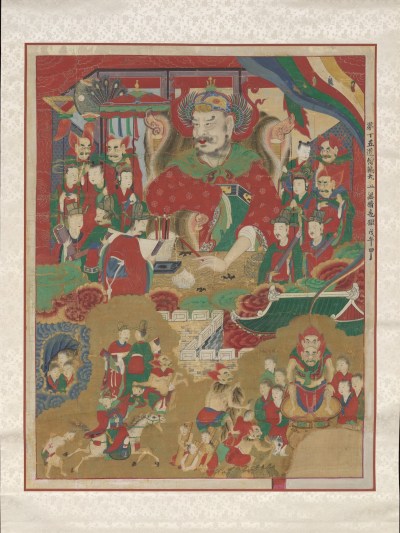The Metropolitan Museum of Art has returned an 18th-century painting to a Korean temple that once housed a vast depiction of hell.
The painting, titled The Tenth King of Hell, dates to 1798 and was made during the Joseon Dynasty. It’s one panel of a 10-part piece known as Siwangdo formerly sited at Sinheungsa Temple in Sokcho, the head temple of the Jogye Order of Korean Buddhism. Each of the panels depicts a king of the afterlife.
According to the Yonhap news agency, the painting was “illicitly” taken from the temple in 1954. By that point, the Korean War had already ended, though the US continued to maintain a presence in the country. “A 1942 survey by the Japanese government-general of Korea recorded the painting’s presence at the temple, and its existence is also documented in photos taken by U.S. military officers between 1953 and 1954,” the news agency said.
The Met quietly announced the return on its website, saying that the work is “believed to have been taken while the Temple was under the control of the United States Army during the Korean War.” The museum said it had purchased the painting in 2007.
According to a provenance on the museum’s site, the Met bought the work from collector Robert Moore via an LLC registered in the name of Michael C. Hughes, who now serves as head of Bonhams’s department for Chinese art. The Met said it had shown The Tenth King of Hell in presentations of its Korean art holdings in 2008 and 2012.
“The Met has a long history of working with colleagues and institutions in Korea, and we look forward to continuing our collaborative efforts to enhance the world’s understanding and appreciation of the arts of Korea,” said Met director Max Hollein in a statement.
Six of the panels of Siwangdo had already made it back to South Korea previously. All six of them were returned in 2020 by the Los Angeles County Museum of Art, which worked on the repatriation with the Jogye Order. LACMA said at the time that the works were “believed to have been looted by United States Army personnel during the Korean War.” The remaining three parts are still abroad, according to Yonhap.
“We are delighted that the Tenth King of Hell has returned to its original home. Our cultural heritage holds its greatest meaning when it is in its rightful place,” said Lee Sang-rae, chairman of the Sokcho Committee for the Return of Cultural Heritage, which worked on the repatriation alongside the temple. “We will continue our efforts to ensure that the remaining three Ten Kings of the Underworld paintings still abroad can also return home.”

The Tenth King of Hell, 1798.
Metropolitan Museum of Art
The Met has indicated an increased willingness to work with foreign nations to return artworks in its holdings. In 2023, the museum launched the Cultural Property Initiative, which asks appointed researchers to review objects in the collection with provenance issues.
In its recently reopened Rockefeller Wing for art from Africa, Oceania, and the ancient Americas, the Met makes provenance information available within the galleries. Some have said that gesture is not enough, however.



